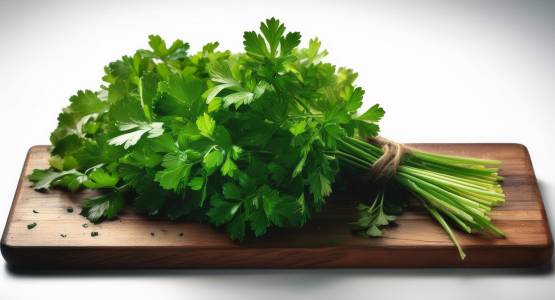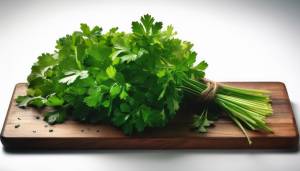A Guide to Growing Parsley in a Greenhouse: Year-Round Freshness for Gardeners


A guide to growing parsley in a greenhouse is an excellent way for gardeners to enjoy this versatile herb all year round. Whether you’re a seasoned gardener or new to greenhouse growing, parsley is a rewarding and low-maintenance crop that provides a constant supply of fresh herbs for cooking. In this guide, we’ll explore everything from choosing the right parsley varieties, caring for the plants, and harvesting tips, to recipes and the health benefits of freshly picked herbs.
Why Grow Parsley in a Greenhouse?
Parsley (Petroselinum crispum) is a biennial herb that thrives in the UK climate, but growing it in a greenhouse offers several advantages:
Year-Round Growing
In Britain, outdoor parsley is typically harvested from spring to autumn. However, in a greenhouse, parsley can be grown and harvested year-round. The controlled environment protects the plant from frost and extreme weather, allowing for a continuous supply.
Protection from Pests
Greenhouse cultivation provides a barrier against common pests that typically attack herbs grown outdoors. By reducing pest pressure, your parsley plants can thrive with minimal damage.
Maximising Space
If you have limited outdoor garden space, a greenhouse allows you to grow parsley alongside other herbs and crops, making the most of every inch.
Stronger, Healthier Plants
A greenhouse provides the perfect growing conditions for parsley, ensuring consistent warmth, light, and moisture, which helps your plants grow healthier and more robust than those exposed to the variability of outdoor weather.
Varieties of Parsley for Greenhouse Growing
There are two main types of parsley: curly leaf and flat-leaf (Italian). Both are suitable for growing in a greenhouse, but they offer different qualities in terms of flavour and texture:
Curly Leaf Parsley (Petroselinum crispum var. crispum)
Curly parsley has decorative, frilly leaves that are often used as a garnish. It has a mild flavour and is more resistant to cold weather, making it a good choice for greenhouse cultivation in the UK’s cooler months.
Flat-Leaf (Italian) Parsley (Petroselinum crispum var. neapolitanum)
Flat-leaf parsley is preferred by chefs for its stronger flavour and smoother texture. It’s ideal for cooking and can be grown successfully in a greenhouse throughout the year. Flat-leaf parsley tends to grow larger and may need more space compared to its curly counterpart.
Both varieties are hardy and will flourish in greenhouse conditions, allowing you to choose based on your preference for flavour and use in the kitchen.
How to Grow Parsley in a Greenhouse
Growing parsley in a greenhouse requires some care, but the process is relatively straightforward. Here’s a step-by-step guide to ensure a thriving crop:
Sowing Seeds
- When to Sow: Parsley seeds can be sown at any time in a greenhouse, but the best time to start is in early spring for a long growing season. For year-round supply, you can sow seeds in succession every few months.
- Seed Preparation: Parsley seeds have a tough outer shell and can be slow to germinate. To speed up the process, soak the seeds in warm water for 24 hours before planting.
- Sowing Depth: Sow the seeds thinly in pots or seed trays filled with well-drained, moist compost, about 1 cm deep.
- Germination Time: Parsley seeds can take up to 3 weeks to germinate. Keep the soil consistently moist and warm (ideally 15–20°C) to encourage sprouting.
Transplanting Seedlings
Once the seedlings have grown to about 5 cm in height and have developed their first true leaves, they can be transplanted into larger pots or directly into greenhouse beds. Make sure to space them about 15–20 cm apart to give each plant room to grow.
Caring for Parsley Plants
- Watering: Parsley thrives in consistently moist soil, but it doesn’t like waterlogging. Water regularly, ensuring the soil remains damp but not overly wet. In the winter months, reduce watering slightly as growth slows.
- Feeding: Parsley benefits from regular feeding. Use a balanced, organic fertiliser every four weeks to keep the plants strong and healthy.
- Temperature and Light: Parsley grows best in mild temperatures between 15–21°C. In the height of summer, ensure the greenhouse is well ventilated to prevent overheating. In winter, keep the greenhouse insulated or use a heater to maintain a steady temperature.
Pruning and Thinning
Parsley can grow bushy and dense if left unchecked. Regularly prune the plants by cutting back the outer leaves to encourage fresh growth. If the plants become too crowded, thin them out to maintain good air circulation.
Common Pests and How to Manage Them
Even in a greenhouse, parsley can still fall victim to pests. Here are the most common culprits and how to deal with them:
Aphids
Aphids can gather on the stems and leaves, sucking the sap and stunting the plant’s growth. To control them, spray the plants with a mixture of water and mild soap or introduce natural predators like ladybirds.
Whitefly
Whiteflies are tiny, white insects that can multiply quickly in a greenhouse. Use sticky traps to catch them or use insecticidal soap as a deterrent.
Slugs and Snails
Although less of a problem inside a greenhouse, slugs and snails can still find their way in, particularly if you’re growing parsley in raised beds. Use copper tape around pots or organic slug pellets to protect your plants.
Harvesting Parsley
When to Harvest
Parsley is ready to harvest 12 to 14 weeks after sowing. You can begin harvesting once the plant has a good number of healthy leaves. For continuous production, only cut the outer leaves, allowing the inner ones to grow and keep the plant productive.
How to Harvest
Use scissors to cut the stems at the base, close to the soil. Avoid pulling the leaves by hand as this can damage the plant. Regular harvesting encourages new growth, so aim to pick leaves every few days.
Storing Parsley
Fresh parsley can be stored in the refrigerator for up to a week. Alternatively, you can freeze parsley by chopping it and placing it in ice cube trays filled with water or olive oil. Dried parsley loses much of its flavour, so freezing is the best option for long-term storage.
Health Benefits of Freshly Picked Parsley
Parsley isn’t just a culinary delight; it’s also packed with health benefits. Freshly picked parsley is rich in vitamins, antioxidants, and essential nutrients that can support overall health:
Rich in Vitamins
Parsley is an excellent source of vitamins A, C, and K. Vitamin A supports eye health, vitamin C boosts the immune system, and vitamin K plays a key role in bone health and blood clotting.
High in Antioxidants
Parsley contains flavonoids and other antioxidants that help neutralise harmful free radicals in the body. This can reduce the risk of chronic diseases like heart disease and cancer.
Supports Digestive Health
Parsley acts as a natural diuretic, helping to reduce bloating and promote kidney health. It also aids digestion by stimulating the production of digestive enzymes.
Bone Health
The high levels of vitamin K in parsley help strengthen bones by improving calcium absorption. Including parsley in your diet regularly can support bone density, especially as you age.
Recipes for Using Freshly Grown Parsley
Fresh parsley is a versatile herb that enhances the flavour of many dishes. Here are some simple ways to use your greenhouse-grown parsley:
Tabbouleh Salad
Tabbouleh is a refreshing Middle Eastern salad made with parsley, mint, bulgur wheat, tomatoes, and lemon juice. The fresh parsley provides the vibrant, herbaceous base of this nutritious dish.
For a twist on traditional pesto, replace basil with parsley. Blend fresh parsley leaves with garlic, pine nuts, olive oil, and Parmesan cheese for a zesty, green pesto that’s perfect for pasta or as a topping for grilled meats.
Gremolata
Gremolata is a classic Italian condiment made from chopped parsley, garlic, and lemon zest. It’s typically served with meat or fish dishes to add a burst of fresh flavour.

Herb Butter
Mix chopped parsley with softened butter, garlic, and a pinch of salt. Herb butter is a delicious way to top grilled steaks, vegetables, or warm bread.
In conclusion, our guide to growing parsley in a greenhouse shows this is a simple and rewarding process that provides a continuous supply of fresh, flavourful herbs all year long. Whether you prefer curly or flat-leaf parsley, this hardy herb thrives in a greenhouse environment with minimal care. Not only does it enhance the flavour of countless dishes, but it also offers significant health benefits, making it a must-grow for every keen gardener in the UK. So, why not start growing parsley today and enjoy the fresh taste and health benefits of home-grown herbs?
